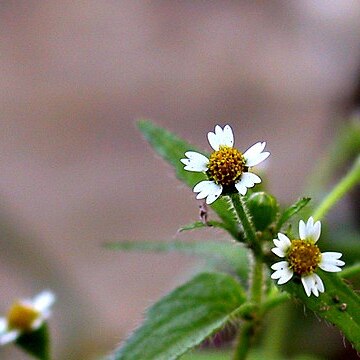Heads small, radiate, the rays few, short, broad, only slightly surpassing the disk, white (pink), pistillate and fertile; invol bracts few, relatively broad, greenish at least in part, several-nerved, each subtending a ray, and sometimes joined at base with the 2 adjacent receptacular bracts; a few shorter and narrower outer bracts often present; receptacle conic, chaffy, its bracts membranous, rather narrow, nearly flat; disk-fls perfect; style-branches flattened, with short, minutely hairy appendage; achenes 4-angled, scarcely compressed, or, especially the outer, somewhat flattened parallel to the invol bracts; pappus of several or many scales, often fimbriate or awn-tipped, that of the rays ± reduced or none; annuals with opposite lvs. 14, originally New World.
Annual herbs. Lvs opposite, simple, usually serrate, 3-veined. Capitula pedunculate, in loose to congested dichasial cymose clusters. Involucral bracts in 1-3 rows. Receptacle conic; scales present. Outer florets ♀, ligulate, white to reddish or purple. Inner florets ☿, tubular. Achenes dimorphic. Ray achenes flattened; pappus of laciniate scales, longer on one side, reduced to hairs, or 0. Disc achenes usually subterete; pappus of subulate to lanceolate, obtuse to aristate, laciniate scales, reduced to bristles, or 0.
Annual herbs. Leaves opposite. Capitula terminal or in upper axils, stalked, heterogamous, radiate; involucre 1–3-seriate; paleae flat. Ray florets female, ray 3-lobed, disc florets hermaphrodite, cylindric, the basal part narrow, 5-toothed; anthers obtuse at base; style arms densely papillose-pubescent. Achenes obovoid, those of ray florets enclosed by a group of phyllaries and paleae; pappus of linear or narrow scales with or without terminal awns, but sometimes absent in ray florets.

